𝑻𝒉𝒆 𝑽𝒊𝒔𝒊𝒕𝒐𝒓 – 𝑯𝒐𝒓𝒓𝒐𝒓 𝑴𝒐𝒗𝒊𝒆

Introducing the Movie The Visitor (2022): A Southern Gothic Horror Tale
The Visitor (2022) is an American psychological horror film that weaves a chilling narrative around the unsettling concept of a doppelgänger and the dark secrets of a small town. Directed by Justin P. Lange and written by Adam Mason and Simon Boyes, the film stars Finn Jones and Jessica McNamee, with supporting performances by Dane Rhodes, Donna Biscoe, and Thomas Francis Murphy. Produced by Blumhouse Television and released digitally on October 7, 2022, by Epix and Paramount Home Entertainment, The Visitor explores themes of identity, fate, and hidden family legacies through a Southern Gothic lens. This article offers a comprehensive introduction to the film, detailing its plot, production, themes, critical reception, and cultural context.
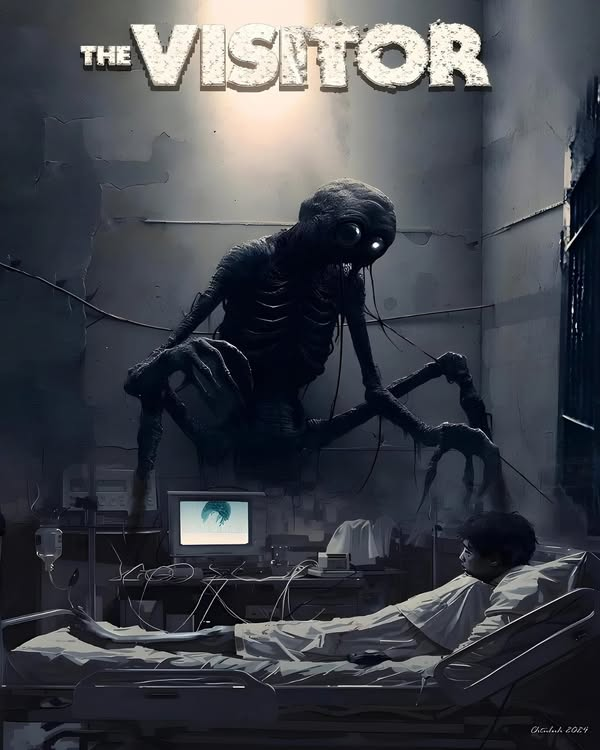
Plot Summary
The Visitor follows Robert (Finn Jones) and his wife Maia (Jessica McNamee), who relocate from London to Maia’s childhood home in the fictional Southern town of Briar Glen, Louisiana, after a series of personal tragedies, including a miscarriage and the death of Maia’s father, Edgar. The couple hopes to rebuild their lives in the dilapidated yet charming country house inherited from Edgar, with dreams of starting a family. However, their idyllic fresh start quickly unravels when Robert discovers an old painting in the attic depicting a man who looks exactly like him, ominously titled “The Visitor.”
As Robert becomes obsessed with uncovering the identity of this mysterious doppelgänger, he encounters similar images of himself in antique shops and local archives, including paintings titled “The Visitor Watches It Burn” and “The Visitor Stakes His Claim.” The townsfolk, including the overly friendly bartender Judy, the cryptic Pastor Ellis (Dane Rhodes), and an antique shop owner, treat Robert with a mix of reverence and unease, hinting at a deeper conspiracy. Strange occurrences escalate—swarms of locusts, infestations of frogs, and ghostly visions plague Robert, while Maia, newly pregnant, dismisses his concerns and urges him to stay.
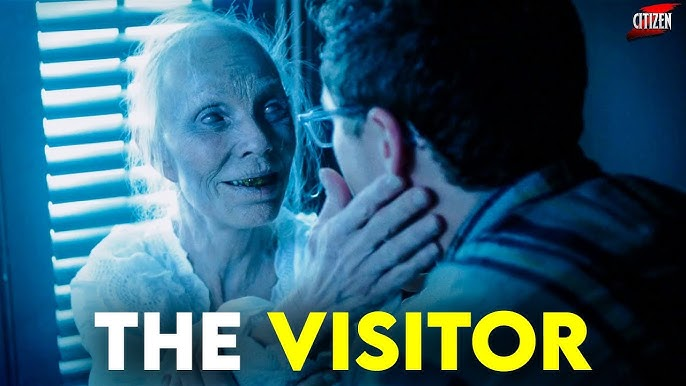
Robert’s investigation leads him to Maxwell Braun, an art dealer who reveals that “The Visitor” appears in historical images tied to catastrophic events, from the Civil War to moments involving figures like Hitler and Saddam Hussein, suggesting a recurring, malevolent entity. As Robert grapples with warnings to flee, Maia’s behavior grows erratic, and the town’s cult-like devotion to “The Visitor” becomes undeniable. The film builds to a shocking climax, unveiling the truth about Robert’s connection to the paintings, Maia’s family legacy, and the town’s sinister rituals, leaving viewers with a haunting, ambiguous resolution.
Production and Development
The Visitor was announced in October 2021 as part of a deal between Blumhouse Television and Epix to produce eight standalone horror and thriller films. Directed by Justin P. Lange, known for The Dark (2018) and The Seventh Day (2021), the film was written by Adam Mason (Songbird) and Simon Boyes (Hangman). Jason Blum served as an executive producer, bringing his signature low-budget, high-concept horror expertise to the project. Filming took place in and around New Orleans, Louisiana, leveraging the region’s swampy, gothic ambiance to enhance the film’s unsettling tone.
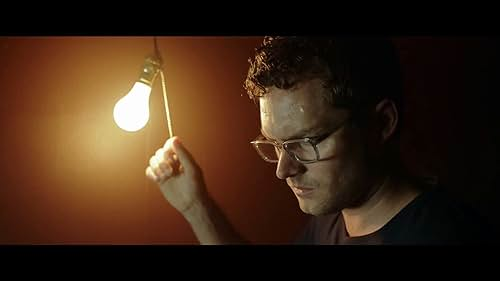
With a modest budget, the production leaned on atmospheric cinematography by Sam Lothridge to create a sense of dread, using muted colors, shadowy interiors, and eerie rural landscapes. Practical effects, such as locust swarms and frog infestations, were paired with minimal CGI to evoke biblical plagues, though some critics noted the visual effects as inconsistent. The paintings of “The Visitor” were a central design element, crafted to appear aged and ominous, with subtle details tying them to the film’s historical references.
The score, composed by Gavin Brivik, features haunting, minimalist tones that amplify the film’s slow-burn tension, though it lacks a standout theme. The film’s 86-minute runtime reflects its streamlined approach, prioritizing mood over expansive world-building. Casting Finn Jones, known for Iron Fist, and Jessica McNamee, seen in The Meg, aimed to draw genre fans, though their chemistry was critiqued as lacking depth. The production faced challenges in balancing its ambitious blend of folk horror, psychological thriller, and supernatural elements, resulting in a film that some praised for its atmosphere but others found narratively disjointed.
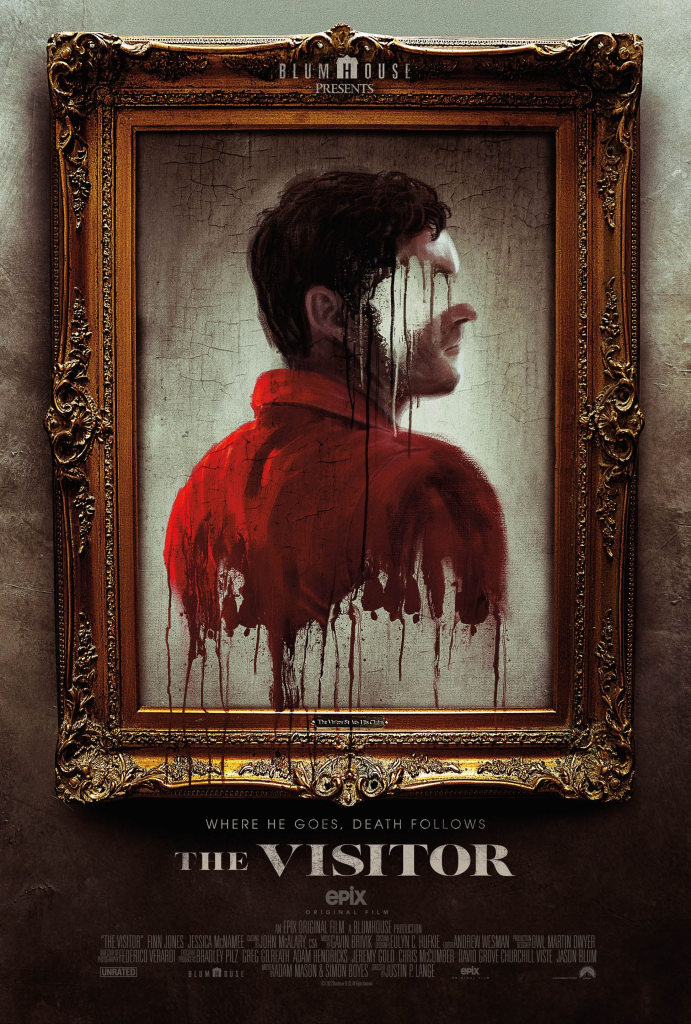
Themes and Symbolism
The Visitor delves into themes of identity, predestination, and the inescapable weight of family secrets. The doppelgänger motif, embodied by the paintings, serves as a metaphor for Robert’s struggle with his sense of self, as he questions whether he is defined by his choices or a predetermined fate. The recurring image of “The Visitor” across history suggests a cyclical, almost antichrist-like force, tying the film to folk horror traditions where ancient evils resurface in modern settings.
The Southern Gothic setting amplifies themes of decay and hidden corruption. Briar Glen, with its overly friendly yet sinister residents, mirrors classics like The Wicker Man, where outsiders are ensnared by insular communities. The town’s cult-like devotion to “The Visitor” reflects themes of blind faith and patriarchal control, particularly through Maia’s family, whose legacy is tied to the entity’s return. Maia’s transformation from supportive wife to complicit insider underscores the film’s critique of gendered roles in horror, though some reviews criticized her portrayal as reductive.
Biblical imagery—locusts, frogs, and crucifixion—infuses the film with an Old Testament sense of divine retribution, positioning “The Visitor” as a harbinger of judgment. The paintings, linked to historical atrocities, symbolize humanity’s capacity for evil, with Robert’s face on them hinting at universal complicity. The film also touches on grief and trauma, as Robert and Maia’s past losses drive their vulnerability to the town’s machinations, though these emotional beats are underdeveloped.
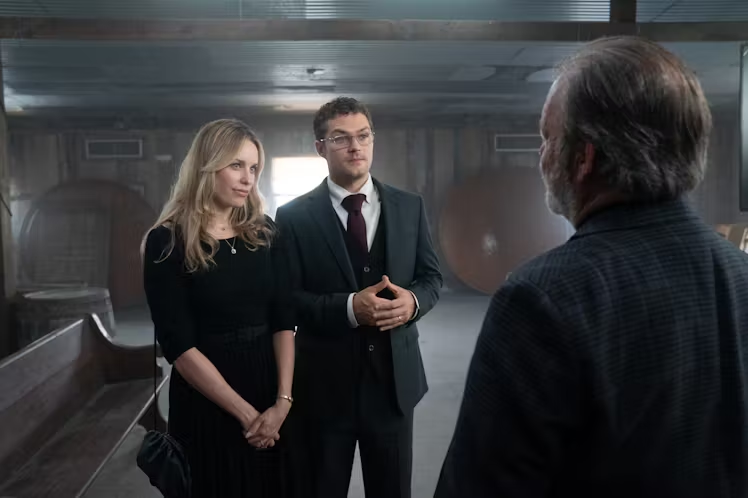
Cast and Characters
The cast of The Visitor delivers varied performances within the film’s constrained narrative:
- Finn Jones as Robert: A British immigrant grappling with his place in Briar Glen, Robert’s descent into paranoia is compelling, though Jones’ performance is sometimes overshadowed by the script’s predictability.
- Jessica McNamee as Maia: Maia’s shift from grieving daughter to secretive antagonist is pivotal, but McNamee’s underutilization limits the character’s depth.
- Dane Rhodes as Pastor Ellis: The town’s foreboding preacher, Rhodes brings gravitas to a stereotypical role, hinting at the town’s dark underbelly.
- Donna Biscoe as Judy: The overly enthusiastic bartender, Biscoe’s performance balances warmth and menace, making Judy a standout.
- Thomas Francis Murphy as Maxwell Braun: The art dealer’s brief but crucial role adds intrigue, with Murphy’s intensity elevating the film’s lore.
Supporting characters, including Victoria Harris as a local, are thinly drawn, serving more as plot devices than fully realized figures. The lack of chemistry between Jones and McNamee, noted by critics, weakens the emotional stakes of their marriage.
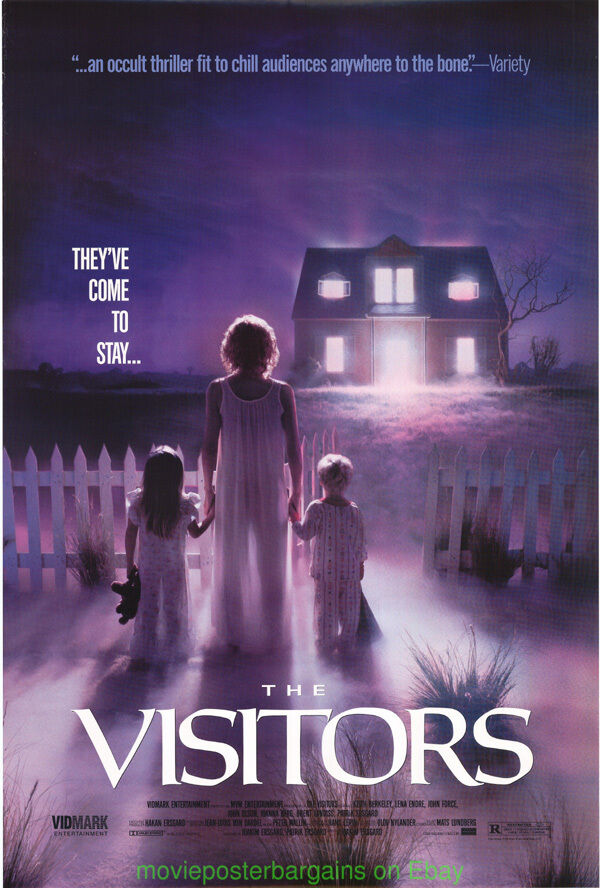
Cultural Impact and Critical Reception
Released digitally on October 7, 2022, with a limited theatrical run, The Visitor garnered mixed reviews, reflecting its ambitious but flawed execution. On Rotten Tomatoes, it holds a low approval rating, with critics split between praising its eerie atmosphere and criticizing its derivative plot and rushed climax. The film’s IMDb score hovers around 4.3/10, with audience reviews ranging from appreciation for its creepy visuals to frustration over its lack of coherence.
Positive reviews, such as from Mother of Movies, lauded its “simmering secrecy” and “well-written ode to mysterious horror,” comparing it to The Wicker Man for its cult-like community dynamics. Horror Guys noted its predictable yet sensible resolution, appreciating the “Wakewood” and “Wicker Man” vibes. However, ScreenRant called it a “horror movie with an identity crisis,” faulting its mash-up of subgenres and clichéd tropes. The New York Times deemed it “tired” and derivative, though not terrible, citing its reliance on small-town horror clichés. IGN criticized its “snail-like pace” and lack of excitement, likening it to “a spoonful of melatonin”.
Audience reactions on platforms like Reddit’s r/horror community were similarly divided. Some found the film “preeeetty good” until the confusing ending, particularly questioning Maia’s blind, deathly appearance and the “Visitor” as an antichrist figure. Others dismissed it as “one of the worst movies” due to its slow pace and nonsensical plot. The film’s low marketing profile, unusual for a Blumhouse production, may have contributed to its muted impact, though its streaming availability on Epix and platforms like Apple TV ensured accessibility.
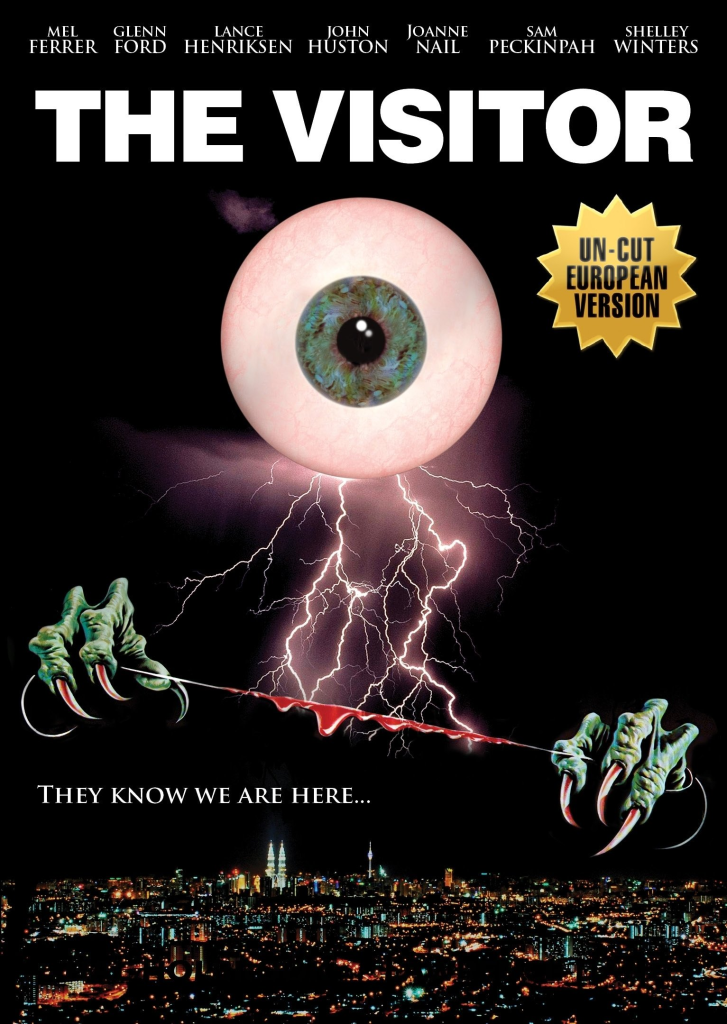
Critical Analysis
The Visitor excels in its early atmosphere, using the Southern Gothic setting and doppelgänger mystery to create unease. Lange’s direction conjures haunting moments, like Robert’s ghostly encounters and the locust swarm death, which evoke visceral horror. The paintings are an effective plot device, their historical scope adding intrigue, though the film struggles to integrate this lore cohesively. The slow-burn approach, while deliberate, overstays its welcome, with the 86-minute runtime feeling padded due to repetitive scenes of Robert’s investigation.
The film’s attempt to blend folk horror, psychological thriller, and biblical horror results in an uneven tone. The twist, telegraphed early but layered with a devilish grin from Jones, is compelling yet rushed, leaving little room for emotional resonance. Maia’s underdeveloped arc and the lack of chemistry with Robert undermine the personal stakes, while the town’s cult feels underwritten compared to genre benchmarks like Midsommar. The biblical plagues are visually striking but underutilized, and the film’s commentary on fate and patriarchy lacks depth, overshadowed by its focus on shock value.
Despite these The Visitor is a flawed but atmospheric entry in Blumhouse’s catalog, offering enough creepy moments to satisfy casual horror fans but falling short of its potential due to narrative inconsistencies and a lack of originality. It serves as a decent, if forgettable, addition to the folk horror subgenre, best suited for viewers who enjoy low-budget chillers with a Southern twist.
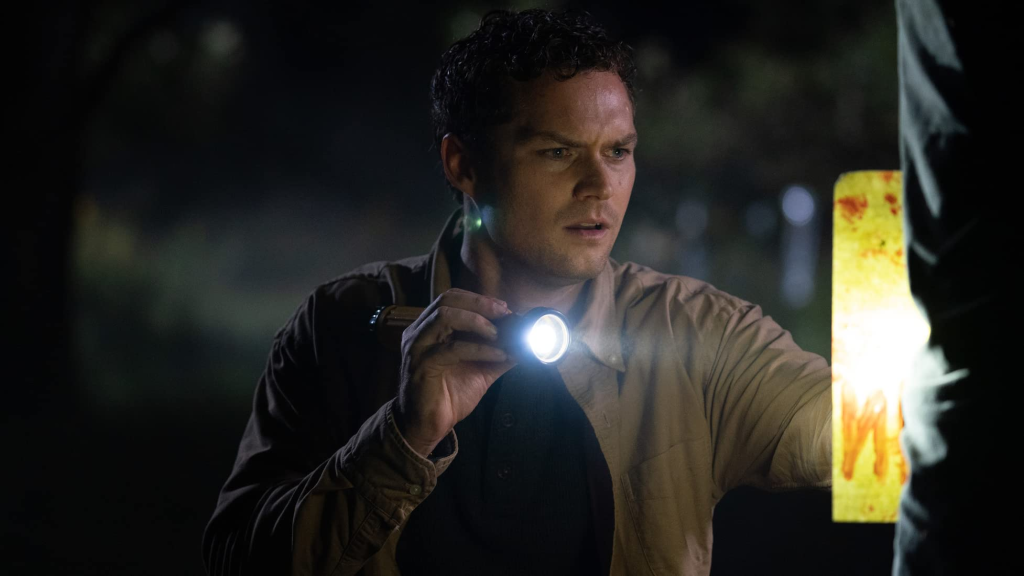
Why The Visitor Resonates
The Visitor taps into primal fears of identity loss and the unknown, using the doppelgänger trope to explore questions of self and destiny. Its Southern Gothic aesthetic and cult-driven horror evoke timeless anxieties about insular communities and buried secrets, resonating with fans of films like The Wicker Man or Kill List. The film’s biblical imagery and antichrist-like figure add a layer of mythic dread, appealing to those intrigued by cosmic horror.
For casual viewers, the film’s accessibility on streaming platforms and its short runtime make it an easy watch for a spooky night in. Its flaws—predictability, uneven pacing, and underdeveloped characters—are offset by its eerie visuals and occasional jolts, making it a serviceable entry for genre enthusiasts. The film’s exploration of grief and marital strain, though shallow, adds a human element that grounds its supernatural elements.
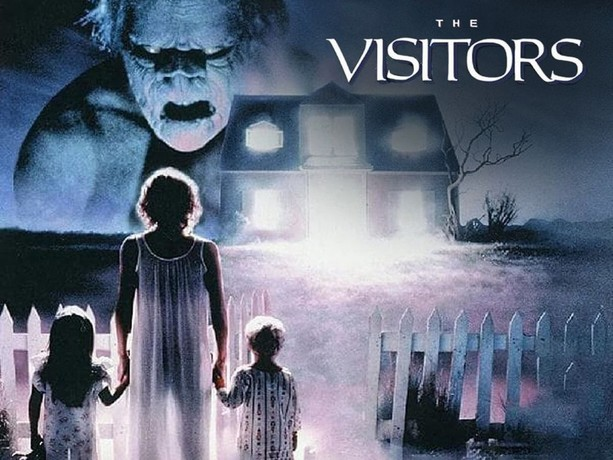
Conclusion
The Visitor (2022) is a chilling, if imperfect, psychological horror film that blends Southern Gothic atmosphere with doppelgänger dread. Directed by Justin P. Lange and backed by Blumhouse, it offers a creepy premise and strong visuals but stumbles with a disjointed narrative and underdeveloped characters. Finn Jones and Jessica McNamee deliver serviceable performances, though the film’s lack of chemistry and rushed climax limit its impact. For fans of folk horror and low-budget thrillers, The Visitor provides enough eerie moments to warrant a watch, particularly for its unsettling take on identity and small-town secrets. While not a standout in the horror genre, it’s a haunting, if forgettable, journey into the shadows of Briar Glen, where the past is never truly buried.